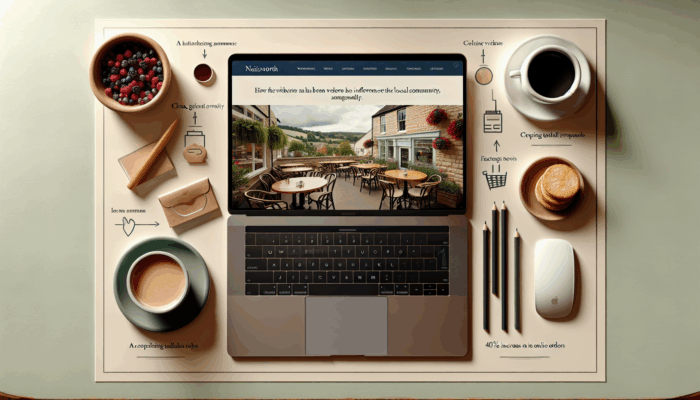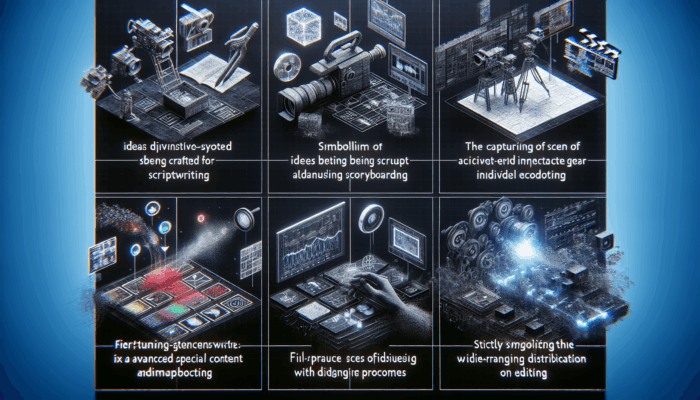Table of Contents
ToggleUnlocking the Transformative Power of Content for Business Success
Utilising Content as a Catalyst for Business Growth

The role of content in the modern business environment transcends mere support; it is a fundamental cornerstone that facilitates significant growth and expansion. In the current digital landscape, characterised by a plethora of consumer choices, crafting high-quality content is essential for attracting and retaining a loyal customer base. Not only does this enhance brand visibility, but it also fosters trust and credibility among potential clients. For instance, a well-researched blog post can position a business as a leading authority in its industry, drawing in readers who are in search of expert insights and guidance. Each piece of content provides a valuable opportunity to connect with target audiences, steering them toward informed purchasing decisions and long-term engagement.
Moreover, effective content marketing strategies can significantly amplify organic traffic, leading to improved conversion rates. This phenomenon is particularly beneficial for local businesses aiming to establish a strong presence within their communities. By leveraging localised content—such as promoting community events, sharing success stories from local customers, or employing effective local SEO practices—businesses can create a deeper resonance with their audience. Consequently, the impact of content is multifaceted; it not only supports short-term sales goals but also plays a crucial role in the enduring development of a resilient brand image that withstands the test of time.
Exploring Varied Content Formats to Enhance Audience Interaction
The key to fostering engagement lies in the diversity and creativity of the content formats employed by a business. Blogs remain a cornerstone, providing a platform for comprehensive storytelling and informative guides that captivate and educate readers effectively. A thoroughly researched blog post can significantly boost a brand’s credibility while also aiding in improved search engine rankings. Furthermore, visual content—including videos, infographics, and stunning images—grabs attention more swiftly than traditional text. Research indicates that incorporating visual elements can dramatically enhance engagement rates, highlighting their vital role in securing and maintaining audience interest across various platforms.
In addition, formats such as podcasts and webinars have gained popularity, offering unique avenues for interaction and audience engagement. These formats allow for more in-depth discussions, tailored to include expert insights or address local issues relevant to specific audiences. Businesses should consider creating content that resonates with the interests and needs of their global audience while ensuring flexibility for local markets. Ultimately, the integration of these diverse formats can weave a rich tapestry of content that captivates audiences and keeps them eager for further interaction and exploration.
Assessing the Effectiveness of Your Content Strategy
Monitoring the performance of your content is crucial in understanding its impact on overall business growth. A variety of analytics tools is available to help businesses evaluate engagement metrics, such as page views, time spent on pages, and bounce rates. These indicators provide valuable insights into which content resonates with audiences and which fails to engage effectively. For instance, if a specific blog post attracts high traffic but shows low engagement, this may suggest that while the topic is appealing, the execution needs improvement for better reader retention.
Beyond engagement metrics, tracking conversions is essential. Understanding how many visitors take actionable steps after engaging with your content—whether that involves subscribing to newsletters, downloading resources, or making purchases—can inform future content strategies and optimisations. Additionally, insights derived from social media analytics can reveal how well content performs across various platforms, empowering businesses to adjust their methodologies accordingly. By systematically collecting and analysing this data, companies can continuously refine their content strategies, ensuring alignment with audience preferences and overarching business objectives.
Formulating a Comprehensive Content Strategy for Success

Identifying and Understanding Your Target Audience
Understanding the characteristics of your target audience is fundamental to developing a successful content strategy. Start this journey with demographic research to ascertain who your customers are—their age, geographical location, interests, and purchasing behaviours. This invaluable data can often be sourced from existing customer databases or gathered through targeted surveys. Once you have established the demographic profile, delve deeper into psychographics; understanding the factors that drive your audience’s purchasing decisions allows you to tailor content effectively to meet their specific needs and preferences.
Creating buyer personas can further clarify your audience’s preferences and behaviours. For example, a local café might discover that their primary clientele consists of young professionals seeking quick, nutritious lunch options. By generating content that speaks directly to this demographic—such as quick recipes or healthy eating tips—the café has the opportunity to engage its audience meaningfully. Additionally, leveraging social listening tools can provide valuable insights into trending topics that resonate with your audience, enabling more targeted and relevant content creation that aligns with their interests.
Setting Clear and Achievable Goals for Your Content
Establishing well-defined objectives for your content is crucial for guiding your efforts and measuring success effectively. Whether your aim is to enhance brand awareness, increase sales, or foster customer loyalty, setting specific, measurable, attainable, relevant, and time-bound (SMART) objectives can significantly strengthen your strategy. For instance, if the objective is to boost website traffic by 30% within the next six months, all content initiatives should align with that goal, focusing on SEO optimisation and shareability.
Content objectives may also vary depending on which stage of the customer journey you are targeting. For example, content aimed at raising awareness might include informative blog posts, while materials designed for consideration could focus on case studies or product comparisons. By mapping out objectives according to the customer journey stages, businesses can create a cohesive content strategy that effectively guides potential customers towards conversion. Regularly revisiting these objectives ensures that they remain relevant to evolving business goals and market dynamics.
Strategically Planning Your Content Calendar for Maximum Impact

A well-structured content calendar serves as an invaluable organisational tool that can help businesses maintain consistency and relevance in their content initiatives. Begin by outlining key themes or topics that are pertinent to your audience, ensuring alignment with your overarching business objectives. This proactive approach facilitates the strategic planning of content types, formats, and publication schedules, which is essential for effective content marketing.
Consider incorporating a blend of evergreen and timely content. Evergreen content retains its relevance over time, encompassing resources like how-to guides or industry best practices, while timely pieces can address current events or emerging trends. By striking a balance between these content types, businesses can create a steady flow of material that engages audiences consistently throughout the year. Moreover, utilising project management tools such as Trello or Google Sheets can enhance the tracking of deadlines, responsibilities, and progress, fostering collaboration among teams and ensuring that everyone is aligned with the content strategy.
Conducting In-Depth Competitor Content Analysis
Assessing competitor content can unveil invaluable insights and highlight gaps within your own strategy. Start by analysing the types of content your competitors produce—be it blogs, videos, or social media posts—and the engagement levels they achieve. Tools like BuzzSumo can be invaluable in gauging which content performs exceptionally well within your niche, offering a benchmark against which to measure your own efforts and identify opportunities for improvement.
Look for opportunities within your competitors’ strategies. For example, if they heavily emphasise video content while neglecting written articles, there may be an opportunity to fill that void by offering comprehensive blog posts that deliver unique value. Furthermore, analysing customer feedback on competitor content can reveal pain points or unmet desires within the market, allowing you to tailor your content to better satisfy audience expectations. By learning from competitors, businesses can refine their content strategies to differentiate themselves and attract their target audiences more effectively.
Measuring and Adapting Your Content Strategy for Continuous Improvement
Regularly assessing the effectiveness of your content strategy is essential for ongoing enhancement and optimisation. Utilise analytics tools to monitor key performance indicators (KPIs) such as website traffic, conversion rates, and engagement metrics. By analysing these data points, businesses can identify which content resonates most with their audience and which areas require optimisation for better performance.
If certain content types or topics consistently underperform, consider investigating the underlying reasons. This could be due to insufficient promotion, inadequate optimisation for search engines, or simply a lack of alignment with audience interests. Based on these insights, businesses can adjust their content strategy accordingly, refining their approach based on what the data reveals. This adaptive mindset not only enhances content effectiveness but also cultivates a culture of continuous learning and growth within the organisation, ensuring that content remains relevant and impactful.
Crafting Captivating and Engaging Content
Creating Compelling Copy That Resonates with Readers
Creating engaging copy is an art that harmonises creativity with strategic thought and planning. Begin by clarifying the core message you wish to convey and the emotions you aim to evoke in your audience. Employ captivating headlines and compelling opening lines that encourage readers to delve deeper into your content. Techniques such as posing thought-provoking questions or presenting intriguing facts can spark interest and invite exploration.
Additionally, maintaining a conversational tone can significantly enhance relatability and connection with your audience. Writing as if you are speaking directly to the reader fosters a relationship that engages them more deeply. Incorporating elements of storytelling can also elevate your content. By weaving narratives that resonate with your audience’s experiences or aspirations, you create a compelling reason for them to engage with your content, whether through comments, shares, or conversions.
Finally, clear calls to action (CTAs) are essential in guiding reader behaviour. Be explicit about what you want your audience to do next, whether it involves subscribing to a newsletter, downloading a resource, or making a purchase. A strong, persuasive CTA can significantly impact conversion rates, transforming passive readers into active participants in your brand’s journey and success.
Key Components for Effective Visual Content
Visual content plays a crucial role in enhancing the overall appeal of your marketing strategy. In an era where attention spans are diminishing, incorporating images, videos, and infographics can significantly boost engagement and retention. Research shows that content featuring visuals is shared more frequently on social media platforms, thereby increasing reach and visibility among target audiences.
Infographics, in particular, serve as powerful tools for conveying complex information in an easily digestible format. They simplify data-heavy subjects, making them accessible and engaging for a wider audience. Alongside infographics, high-quality images and videos can help showcase products or services in ways that text alone cannot achieve. For instance, a travel agency might leverage visually stunning videos of destinations to entice potential clients, creating an emotional connection through immersive storytelling that resonates with viewers.
To maximise the efficacy of visual content, ensure it aligns with your branding and messaging. Consistency in style, colour, and tone across all visual elements reinforces brand identity, making it easier for audiences to recognise your content amidst the digital noise. Investing in professional-quality visuals can yield substantial returns in terms of audience engagement and overall brand perception, enhancing your marketing efforts significantly.
Utilising Storytelling to Build Strong Brand Connections
Storytelling is an impactful technique that can forge deep connections between brands and their audiences. Rather than simply presenting facts or figures, effective storytelling invites the audience into a narrative that resonates on an emotional level. This can be achieved by sharing relatable experiences or highlighting customer testimonials that showcase how your products or services have positively impacted their lives.
Consider the effect of a well-crafted brand story that reflects your mission, values, and the journey of overcoming challenges. This not only humanises your brand but also creates a shared experience with your audience. For instance, a small coffee shop might narrate how it ethically sources its beans from local farmers, inviting customers to participate in a broader narrative that supports sustainability and ethical practices within the community.
Moreover, integrating storytelling elements across various content types—blogs, videos, and social media—can create a cohesive brand narrative. Consistency in storytelling builds trust and loyalty, encouraging audiences to engage with your content and share it within their networks. Ultimately, effective storytelling has the power to transform your content from mere marketing material into a powerful tool for nurturing lasting relationships with your audience, fostering community and brand advocacy.
Optimising Content for Superior Search Engine Performance
Conducting Effective Keyword Research and Implementation
Thorough keyword research forms the cornerstone of successful content optimisation and visibility. Start by identifying relevant keywords and phrases that your target audience is actively searching for across search engines. Tools such as Google Keyword Planner and SEMrush can provide insights into search volume, competition levels, and related keywords. Understanding this data enables businesses to select keywords that align with their content goals and audience intent, ensuring that their efforts are focused and effective.
Once identified, the seamless integration of keywords into your content is paramount. Strive for a natural flow that enhances readability while ensuring that keywords are present in critical areas, including the title, headings, and throughout the main body. Overstuffing keywords can lead to a negative user experience and may incur penalties from search engines for over-optimisation. Instead, focus on crafting valuable, informative content that naturally incorporates keywords, maintaining a balance between optimisation and quality for the best results.
Moreover, consider the utilisation of long-tail keywords, which are often less competitive and can attract highly targeted traffic. For instance, instead of targeting a broad term like “shoes,” a retailer might focus on “sustainable running shoes for women.” This specificity can lead to higher conversion rates, as the audience searching for these terms is likely further along in the purchasing journey and thus more inclined to convert.
Implementing On-Page SEO Techniques for Enhanced Visibility
On-page SEO is vital for ensuring that individual web pages rank favourably in search engine results. Begin by optimising title tags and meta descriptions, as these are the first elements potential visitors will encounter in search results. Craft compelling, keyword-rich titles that accurately reflect the content while enticing users to click through and explore further.
Headings and subheadings also play a critical role in enhancing readability and SEO. Utilise H1, H2, and H3 tags effectively to break up content into manageable sections, making it easier for both users and search engines to grasp the structure of your page. Additionally, incorporating internal links to relevant content within your website can improve navigation and contribute to superior search rankings, further enhancing user experience and engagement.
Image optimisation represents another essential facet of on-page SEO. Ensure that images are compressed to reduce loading times, and employ descriptive alt text to enhance accessibility while providing context for search engines. This comprehensive approach to on-page SEO not only boosts search engine rankings but also improves user experience, ultimately driving increased traffic to your site and enhancing overall performance.
Establishing Quality Backlinks for Enhanced Authority
Acquiring high-quality backlinks is crucial for enhancing your website’s authority and improving search rankings. Start by producing valuable, shareable content that naturally attracts links from other websites. High-quality blog posts, infographics, and in-depth research reports are excellent candidates for earning backlinks, as these resources may be referenced by others within your industry, increasing your credibility and visibility.
Establishing connections within your industry can also yield valuable backlink opportunities. Engaging with influencers, participating in guest blogging, and collaborating on projects can enhance your credibility and visibility. When seeking backlinks, focus on nurturing genuine relationships, as this approach will result in more meaningful and relevant links that contribute positively to your site’s authority.
Additionally, consider employing tools like Moz or Ahrefs to analyse your backlink profile and pinpoint opportunities for improvement. Understanding where your competitors acquire their links can inform your strategy for your own content. By prioritising high-quality backlinks from reputable sources, businesses can significantly bolster their online presence, enhancing both search visibility and authority in a competitive landscape.
Maximising the Impact of Social Media for Content Distribution
Selecting the Right Social Media Platforms for Your Audience
Choosing the most suitable social media platforms is essential for effectively reaching your target audience. Begin by assessing where your audience spends their time online. For instance, younger demographics may gravitate towards platforms like Instagram and TikTok, while professionals may favour LinkedIn. Tailoring your approach to each platform ensures that your content reaches the right individuals in the right context, fostering engagement and interaction.
Once you’ve identified the platforms that align with your audience, invest time in understanding their unique features and functionalities. Each platform possesses its own nuances; hence, adjusting your content style accordingly can enhance engagement. For example, Instagram thrives on visually captivating content, while Twitter is ideal for concise, impactful messaging that resonates with users in a fast-paced environment.
Furthermore, consider the level of interaction you aim to achieve. Platforms that encourage community engagement, such as Facebook and Reddit, can facilitate deeper connections with your audience, enabling more meaningful conversations around your brand and its offerings. By selecting the right platforms, businesses can maximise their reach and impact, ultimately driving engagement and fostering brand loyalty among their followers.
Creating Shareable Content That Resonates with Your Audience
Producing content that motivates sharing is vital for amplifying your reach across social media platforms. Start by generating high-quality, valuable content that aligns with your audience’s interests and needs. Infographics, videos, and interactive content typically perform exceptionally well, as they are visually engaging and easy to share across various channels.
Integrating share buttons on your website and within your content can streamline this sharing process. Encourage your audience to share your content by including clear calls to action, such as “Share this post if you found it helpful!” Additionally, strategically timing your posts can amplify visibility. Posting during peak engagement periods for your audience maximises the likelihood of shares and interactions, significantly enhancing your overall reach and impact.
Consider leveraging the power of user-generated content as well. Encouraging your followers to share their experiences with your brand not only expands your reach but also cultivates a sense of community and belonging. This collaborative approach to content creation can lead to organic growth, as satisfied customers become advocates for your brand, sharing their positive experiences within their networks and driving further engagement.
Fostering Meaningful Engagement with Your Audience
Engagement is a reciprocal process; it is crucial for businesses not only to post content but also to actively interact with their audience. Promptly responding to comments, messages, and mentions can cultivate a sense of community and loyalty among followers. This level of engagement demonstrates that you value your audience’s input and are committed to building meaningful relationships that foster trust and long-term loyalty.
Hosting Q&A sessions or live events on social media can also dramatically enhance engagement. These interactive formats offer opportunities for direct communication and allow followers to connect with your brand on a personal level. Additionally, sharing behind-the-scenes content or stories humanises your brand, making it more relatable and approachable to your audience, thus encouraging further interaction.
Moreover, leveraging polls and surveys can yield valuable insights into your audience’s preferences and interests. Not only does this engage your audience by involving them in the content creation process, but it also equips your business with the information necessary to develop more targeted and relevant content in the future, ensuring alignment with audience needs and expectations.
Effectively Leveraging Email Marketing for Business Growth
Strategies for Building and Growing Your Email Subscriber List
An engaged email list is an invaluable asset for any business, providing a direct line of communication with your audience. Start by implementing effective lead magnets—offer enticing resources, such as e-books, discounts, or exclusive content, in exchange for email sign-ups. This strategy not only incentivises potential subscribers but also delivers immediate value right from the outset, encouraging ongoing engagement.
Promoting your email sign-up across various channels—your website, social media, and during webinars—can effectively expand your subscriber base. Furthermore, consider segmenting your email list based on demographics or behaviours to tailor your messaging more effectively. Segmenting allows businesses to send targeted content that resonates more deeply with distinct audience groups, enhancing engagement and response rates, leading to higher conversion potential.
Regularly cleansing your email list to remove inactive subscribers can also improve deliverability rates and engagement metrics. By maintaining a high-quality list, businesses can ensure that their email campaigns reach an interested audience, ultimately driving improved conversion rates and maximising the effectiveness of their email marketing efforts.
Designing Impactful Email Campaigns That Drive Results
Creating impactful email campaigns necessitates a thoughtful approach that resonates with your audience. Begin by crafting attention-grabbing subject lines that entice recipients to open your emails. A/B testing different subject lines can yield insights into what resonates most effectively with your audience, allowing for ongoing optimisation.
The content within the email should be concise yet engaging. Utilise clear, compelling language and incorporate visuals to break up text and enhance readability. Adding personalised elements, such as using the recipient’s name or referencing their previous interactions with your brand, can significantly boost engagement rates and enhance the overall recipient experience.
Including strong calls to action (CTAs) is essential in guiding recipients towards desired actions. Whether it’s visiting your website, making a purchase, or signing up for an event, clear, persuasive CTAs can drive conversions and ensure that your email campaigns contribute meaningfully to overall business growth and success.
Assessing the Performance of Your Email Campaigns
Evaluating the success of your email campaigns is crucial for ongoing improvement and refinement. Track key metrics such as open rates, click-through rates (CTR), and conversion rates to assess effectiveness. Understanding these metrics enables businesses to identify which campaigns resonate best with their audience and which require further optimisation for improved performance.
Utilising A/B testing can also provide valuable insights into what works most effectively. Experimenting with different subject lines, content formats, or CTAs can reveal preferences among your audience, allowing for more tailored future campaigns. Furthermore, consider assessing the engagement of different segments within your email list. This can illuminate trends and preferences that inform your overall email strategy and enhance effectiveness.
Regularly analysing your email performance will not only help optimise future campaigns but also enhance overall engagement and conversions. By continually refining your approach based on data-driven insights, businesses can maximise the effectiveness of their email marketing efforts and drive sustained growth.
Enhancing Email Deliverability for Optimal Campaign Success
Ensuring that your emails successfully reach the inbox rather than the spam folder is crucial for the success of your campaigns. Start by verifying that your email list is clean and up-to-date, removing inactive subscribers and rectifying any invalid addresses. This practice can enhance your sender reputation, increasing the likelihood that your emails will be successfully delivered to your audience.
Utilising authentication protocols, such as SPF and DKIM, can also bolster deliverability. These protocols verify the authenticity of your emails, reducing the chances of them being marked as spam by email providers. Additionally, avoid employing excessively promotional language in your emails, as this may trigger spam filters. Instead, concentrate on delivering value and nurturing genuine connections with your audience through your messaging.
Monitoring your email metrics can help identify potential deliverability issues. If you observe a decline in open rates or an uptick in bounce rates, investigate further to ascertain the cause and implement corrective actions. By prioritising email deliverability, businesses can ensure their campaigns effectively reach their audience and contribute to overall marketing success and engagement.
Maximising the Value of Content Repurposing for Broader Reach
Identifying High-Value Content for Repurposing
Content repurposing involves taking existing material and transforming it into new formats to reach broader audiences more effectively. Start by reviewing your current content library to identify pieces that have performed well but could benefit from a fresh perspective or format. For example, a popular blog post can be adapted into a video or infographic, providing a new and engaging way to connect with your audience and extend its lifecycle.
Consider repurposing content for different platforms as well. A webinar could be segmented into shorter video snippets for social media sharing, or key points could be summarised in a series of tweets. This approach not only expands your content reach but also maximises the value derived from your initial content investment, allowing you to leverage your work across multiple channels.
Identifying evergreen content—pieces that maintain their relevance over time—is particularly advantageous for repurposing. By refreshing and adapting these pieces for new audiences or platforms, businesses can continually attract traffic and engagement without the need to create entirely new content from scratch, thus conserving resources while maximising impact.
Adapting Content for Diverse Formats to Enhance Engagement
Adapting content for different formats necessitates creativity and strategic thinking. Begin by pinpointing the core message of your original content and consider how it can be effectively conveyed through various mediums. For instance, a written blog post can be transformed into a podcast by discussing the key points in an engaging conversational format, broadening its reach.
When converting content, take into account the preferences of your target audience. For example, younger audiences may favour video content, while professionals might engage more with in-depth articles or research reports. Tailoring the format to suit audience preferences enhances engagement and increases the likelihood of content sharing, thereby amplifying your overall reach.
Furthermore, ensure that the repurposed content retains the essence of the original message while being adapted for the new format. This consistency across all content types helps maintain a cohesive brand voice, regardless of how the message is communicated, further reinforcing your brand identity and values.
Simplifying Content Distribution Through Automation for Efficiency
Automating content distribution can streamline efforts and ensure that your content reaches audiences efficiently and effectively. Utilising social media management tools, such as Hootsuite or Buffer, enables businesses to schedule posts across various platforms in advance. This not only saves time but also guarantees that content is consistently shared, even during peak engagement times, maximising visibility and interaction.
Consider automating email campaigns using platforms like Mailchimp or Constant Contact. These tools allow businesses to establish automated workflows that deliver targeted content to subscribers based on their behaviours or preferences. This level of personalisation can significantly enhance engagement and conversion rates, ensuring that your messaging resonates with your audience.
Moreover, leveraging analytics tools can assist in tracking the performance of automated content distribution. By monitoring engagement metrics and adjusting strategies accordingly, businesses can ensure that their automated efforts align with audience interests and preferences. Automating content distribution enhances efficiency, allowing businesses to concentrate on creating high-quality content while maximising reach and impact.
Frequently Asked Questions About Content Strategy and Marketing
What role does content play in driving local business growth?
Content plays a pivotal role in attracting customers, enhancing brand visibility, and establishing credibility, all of which contribute significantly to the growth of local businesses within their communities.
How can I measure the effectiveness of my content?
You can gauge content effectiveness by tracking metrics such as engagement rates, conversion rates, and overall website traffic using various analytics tools that provide comprehensive insights.
What types of content tend to engage audiences the most?
Engaging content encompasses blogs, videos, infographics, and interactive formats that resonate with the interests and needs of the audience, fostering deeper connections.
How do I identify my target audience for content creation?
Identify your target audience by analysing demographic data, psychographics, and conducting market research to gain insights into their preferences and behaviours, tailoring content accordingly.
What are some effective strategies for email marketing?
Effective email marketing strategies include building a quality email list, crafting impactful messages, and regularly analysing performance to optimise future campaigns for better results.
How can I leverage social media for effective content distribution?
Leverage social media by selecting the right platforms, creating shareable content, and actively engaging with your audience to cultivate a vibrant community around your brand.
What is content repurposing, and why is it significant?
Content repurposing involves transforming existing content into new formats, maximising its value and reach while conserving time and resources for greater efficiency and impact.
How can I enhance my website’s SEO performance?
Improve SEO by conducting thorough keyword research, optimising on-page elements, building quality backlinks, and consistently creating high-quality content that meets user intent.
What influence does storytelling have in content marketing?
Storytelling strengthens emotional connections with audiences, making content more relatable and memorable, ultimately boosting engagement and fostering brand loyalty over time.
Which tools can assist with content automation and distribution?
Tools like Hootsuite, Buffer, Mailchimp, and Constant Contact can aid in automating content distribution and email marketing efforts, enhancing efficiency and effectiveness.
Engage with us on Facebook!
The post Leverage Content for Local Business Growth: A Universal Guide appeared first on Ezi Gold.
















